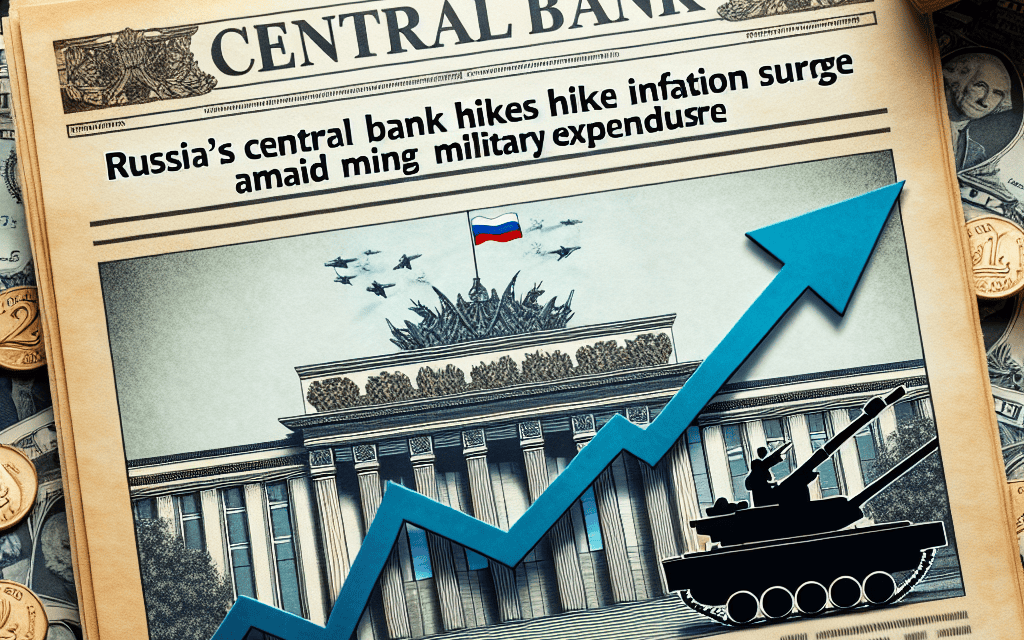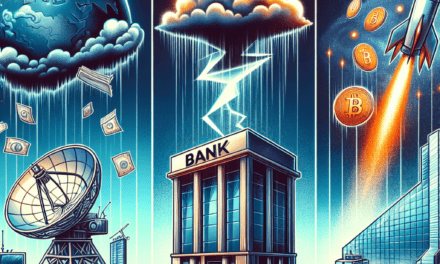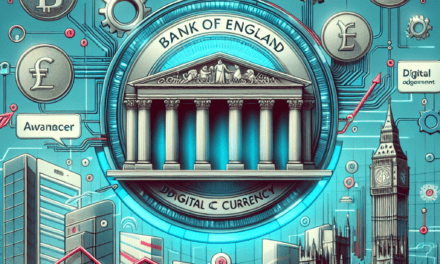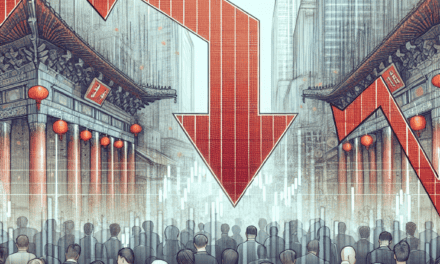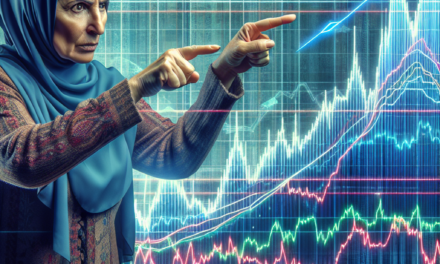“Russia’s Central Bank Battles Inflation Surge with Bold 21% Rate Hike Amid Rising Military Costs.”
Introduction
In response to escalating inflation driven by increased military expenditure, Russia’s Central Bank has made a decisive move by raising its key interest rate to 21%. This significant hike aims to stabilize the national currency and curb rising consumer prices, which have been exacerbated by the financial demands of ongoing military operations. The decision underscores the central bank’s commitment to maintaining economic stability in the face of mounting fiscal pressures and geopolitical tensions. As the country grapples with the economic fallout of its military activities, this monetary policy adjustment reflects a strategic effort to mitigate inflationary risks and preserve financial equilibrium.
Impact Of Russia’s Interest Rate Hike On Domestic Economy
Russia’s recent decision to raise its central bank interest rate to 21% marks a significant move in response to the mounting inflation pressures exacerbated by increased military expenditure. This monetary policy adjustment is poised to have profound implications for the domestic economy, influencing various sectors and the financial well-being of Russian citizens. As the country grapples with the economic ramifications of its military commitments, the central bank’s decision underscores the delicate balance between fiscal policy and economic stability.
The immediate impact of the interest rate hike is likely to be felt in the borrowing costs for businesses and consumers. Higher interest rates typically lead to increased costs for loans and credit, which can dampen consumer spending and business investment. For businesses, particularly small and medium-sized enterprises, the elevated borrowing costs may result in reduced capital expenditure, potentially stalling expansion plans and innovation. Consequently, this could lead to slower economic growth, as businesses may become more cautious in their financial planning.
Moreover, the housing market is expected to experience a slowdown as mortgage rates rise in tandem with the central bank’s interest rate. Prospective homebuyers may find it more challenging to afford mortgages, leading to a decrease in demand for housing. This could result in a cooling of the real estate market, affecting construction companies and related industries. Additionally, existing homeowners with variable-rate mortgages might face higher monthly payments, which could strain household budgets and reduce disposable income.
On the other hand, the interest rate hike aims to curb inflation by making borrowing more expensive and encouraging savings. By increasing the cost of credit, the central bank hopes to reduce consumer spending, thereby alleviating inflationary pressures. This approach, while potentially effective in stabilizing prices, may also lead to a contraction in economic activity. The challenge lies in striking a balance between controlling inflation and maintaining economic growth.
Furthermore, the interest rate increase could have implications for the Russian ruble. A higher interest rate often attracts foreign investment, as investors seek higher returns on their capital. This influx of foreign capital could strengthen the ruble, making imports cheaper and potentially easing some inflationary pressures. However, the geopolitical context and international sanctions may complicate this dynamic, as foreign investors weigh the risks associated with investing in Russia.
In addition to these economic considerations, the central bank’s decision reflects the broader fiscal challenges facing Russia. The surge in military expenditure has placed additional strain on the national budget, necessitating measures to manage inflation and maintain economic stability. The interest rate hike is part of a broader strategy to address these fiscal pressures, but it also highlights the trade-offs involved in prioritizing military spending over other economic objectives.
In conclusion, Russia’s central bank interest rate hike to 21% is a critical response to the inflationary surge driven by increased military expenditure. While the move aims to stabilize prices and attract foreign investment, it also poses challenges for domestic economic growth and consumer spending. The impact on borrowing costs, the housing market, and the ruble will be closely monitored as the country navigates the complex interplay between fiscal policy and economic stability. As Russia continues to address its fiscal challenges, the central bank’s actions will play a pivotal role in shaping the country’s economic trajectory.
Inflation Surge In Russia: Causes And Consequences
In recent developments, Russia’s central bank has made a significant move by raising its key interest rate to 21%, a decision driven by the urgent need to combat soaring inflation. This drastic measure comes in response to the mounting economic pressures stemming from increased military expenditure, which has significantly strained the nation’s financial stability. The decision underscores the central bank’s commitment to stabilizing the economy, even as it grapples with the complex interplay of domestic and international factors contributing to the current inflationary surge.
The primary catalyst for this inflationary pressure is the substantial increase in military spending, a strategic choice that has had far-reaching economic implications. As the government channels more resources into defense, it inadvertently fuels inflation by increasing demand for goods and services, thereby driving up prices. This situation is further exacerbated by supply chain disruptions and global economic uncertainties, which have collectively contributed to the rising cost of living in Russia. Consequently, the central bank’s decision to hike interest rates is aimed at curbing consumer spending and cooling down the overheated economy.
Moreover, the central bank’s move reflects a broader strategy to maintain the stability of the Russian ruble, which has faced significant depreciation pressures. By raising interest rates, the central bank seeks to attract foreign investment and bolster the currency’s value, thereby mitigating the risk of further devaluation. This approach is crucial in maintaining investor confidence and ensuring that the Russian economy remains resilient in the face of external shocks. However, this policy decision is not without its challenges, as higher interest rates can also stifle economic growth by increasing borrowing costs for businesses and consumers alike.
In addition to addressing immediate inflationary concerns, the central bank’s decision highlights the delicate balance policymakers must strike between fostering economic growth and ensuring price stability. While the rate hike is a necessary step to rein in inflation, it also poses potential risks to economic expansion, particularly in sectors heavily reliant on credit. As borrowing becomes more expensive, businesses may scale back investments, leading to slower economic growth and potentially higher unemployment rates. This underscores the importance of complementary fiscal policies that can support economic activity while maintaining fiscal discipline.
Furthermore, the central bank’s actions have significant implications for the broader geopolitical landscape. As Russia navigates its economic challenges, it must also contend with the impact of international sanctions and fluctuating global energy prices, which have further complicated its economic outlook. The interplay between domestic policy decisions and external economic forces underscores the complexity of managing inflation in an interconnected world. Consequently, Russia’s central bank must remain vigilant and adaptable, ready to adjust its policies in response to evolving economic conditions.
In conclusion, the decision by Russia’s central bank to raise interest rates to 21% is a critical step in addressing the country’s inflationary surge, driven largely by increased military expenditure. While this move aims to stabilize the economy and strengthen the ruble, it also presents challenges that require careful navigation. As Russia continues to grapple with both domestic and international economic pressures, the central bank’s actions will play a pivotal role in shaping the country’s economic trajectory. Ultimately, the success of these measures will depend on a balanced approach that fosters economic resilience while safeguarding price stability.
Military Expenditure And Its Effect On Russia’s Financial Stability
Russia’s recent decision to raise its central bank interest rate to 21% marks a significant move in response to the mounting inflation pressures exacerbated by increased military expenditure. This development underscores the intricate relationship between defense spending and economic stability, highlighting the challenges faced by nations that prioritize military investments. As Russia continues to allocate substantial resources to its military operations, the ripple effects on its financial stability become increasingly evident.
The surge in military expenditure, driven by geopolitical tensions and strategic objectives, has placed a considerable strain on Russia’s economy. This heightened spending has necessitated a reallocation of resources, diverting funds from other critical sectors such as healthcare, education, and infrastructure. Consequently, the domestic economy faces the dual challenge of managing inflationary pressures while ensuring sustainable growth. The central bank’s decision to hike interest rates is a strategic attempt to curb inflation, stabilize the currency, and restore investor confidence. However, this move also carries potential risks, as higher interest rates can dampen economic growth by increasing borrowing costs for businesses and consumers alike.
In examining the broader implications of Russia’s military expenditure, it is essential to consider the impact on the nation’s fiscal health. The increased defense budget has led to a rise in public debt, as the government seeks to finance its military ambitions. This growing debt burden poses a threat to long-term financial stability, as it may limit the government’s ability to respond to future economic challenges. Moreover, the focus on military spending can lead to a crowding-out effect, where private investment is discouraged due to higher interest rates and reduced availability of credit. This scenario can stifle innovation and hinder the development of a diversified economy, further exacerbating the nation’s economic vulnerabilities.
Furthermore, the inflationary pressures resulting from military expenditure have significant social implications. As the cost of living rises, households face increased financial strain, particularly those with fixed or low incomes. This situation can lead to a decline in consumer spending, which is a critical driver of economic growth. Additionally, inflation can erode savings, diminishing the purchasing power of citizens and potentially leading to social unrest. The central bank’s interest rate hike aims to address these inflationary concerns, but it also highlights the delicate balance policymakers must strike between maintaining economic stability and supporting national security objectives.
In this context, it is crucial for Russia to explore strategies that can mitigate the adverse effects of military expenditure on its financial stability. Diversifying the economy and reducing reliance on defense spending could help create a more resilient economic framework. Investing in sectors such as technology, renewable energy, and manufacturing could stimulate growth and provide alternative sources of revenue. Additionally, enhancing transparency and accountability in defense spending could ensure that resources are utilized efficiently, minimizing waste and corruption.
In conclusion, Russia’s decision to raise its central bank interest rate to 21% reflects the complex interplay between military expenditure and economic stability. While the move aims to address inflationary pressures, it also underscores the broader challenges associated with prioritizing defense spending. As Russia navigates these economic complexities, it must carefully balance its national security objectives with the need to maintain financial stability and promote sustainable growth. By adopting a more diversified economic approach and ensuring efficient resource allocation, Russia can work towards achieving a more stable and prosperous future.
How Russia’s Central Bank’s Decision Affects Global Markets
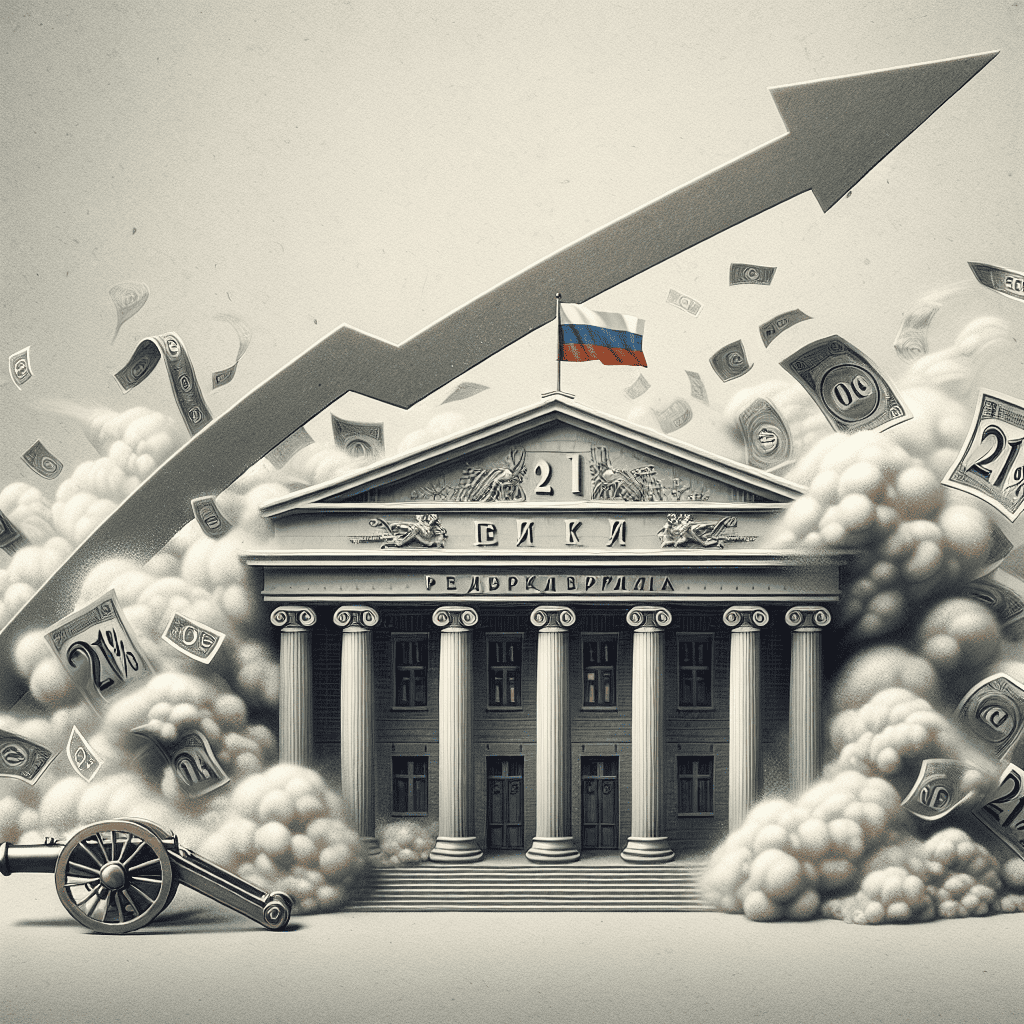
Russia’s Central Bank recently made a significant move by raising its key interest rate to 21%, a decision driven by the surging inflation largely attributed to increased military expenditure. This development has not only captured the attention of economists and policymakers within Russia but has also sent ripples across global markets. The decision to hike the interest rate is primarily aimed at curbing inflationary pressures that have been exacerbated by the country’s heightened military spending. As Russia allocates more resources to its defense sector, the resultant fiscal strain has contributed to rising prices, necessitating a robust monetary response. By increasing the interest rate, the Central Bank aims to stabilize the ruble and control inflation, thereby safeguarding the purchasing power of its citizens.
However, the implications of this decision extend far beyond Russia’s borders. In the interconnected world of global finance, such a significant policy shift can influence investor sentiment and capital flows. For instance, higher interest rates in Russia may attract foreign investors seeking better returns, potentially leading to an appreciation of the ruble. This, in turn, could impact the competitiveness of Russian exports, affecting trade balances with other countries. Moreover, the decision could also have a bearing on global commodity markets. Russia is a major player in the energy sector, and any fluctuations in its currency or economic stability can influence oil and gas prices worldwide. A stronger ruble might lead to higher costs for Russian energy exports, which could ripple through global supply chains and affect energy prices in various regions.
Furthermore, the Central Bank’s move may prompt other countries to reassess their monetary policies. In a global economy still recovering from the disruptions of the COVID-19 pandemic, central banks are closely monitoring inflation trends and economic stability. Russia’s decision could serve as a precedent for other nations grappling with similar inflationary pressures, potentially leading to a wave of interest rate hikes across emerging markets. This scenario could have profound implications for global economic growth, as higher borrowing costs might dampen investment and consumer spending.
In addition to these economic considerations, the geopolitical context cannot be overlooked. Russia’s increased military expenditure is closely tied to its strategic objectives, and the Central Bank’s decision reflects the broader economic challenges arising from these priorities. As tensions persist in various geopolitical hotspots, the financial markets remain sensitive to any developments that could escalate or de-escalate conflicts. Consequently, investors are likely to keep a close watch on Russia’s economic indicators and policy decisions, as these could provide insights into the country’s future trajectory.
In conclusion, Russia’s Central Bank’s decision to raise the interest rate to 21% is a multifaceted development with far-reaching consequences. While it aims to address domestic inflationary pressures, the move also has significant implications for global markets. From influencing investor behavior and commodity prices to potentially setting a precedent for other central banks, the decision underscores the intricate linkages between national policies and the global economic landscape. As the situation continues to evolve, stakeholders worldwide will be keenly observing how Russia navigates these challenges and the subsequent impact on international financial stability.
Strategies For Russian Businesses To Cope With High Interest Rates
In the wake of Russia’s Central Bank decision to raise the interest rate to an unprecedented 21%, businesses across the nation are grappling with the implications of this monetary policy shift. This move, primarily driven by the need to curb inflation exacerbated by increased military expenditure, presents a formidable challenge for Russian enterprises. As borrowing costs soar, companies must adopt strategic measures to navigate this high-interest environment effectively.
To begin with, businesses should prioritize enhancing their financial management practices. This involves conducting a thorough review of their current financial standing, including cash flow, debt levels, and investment portfolios. By gaining a clear understanding of their financial health, companies can identify areas where they can cut costs or reallocate resources more efficiently. Moreover, maintaining a robust cash flow becomes crucial in such times, as it provides the liquidity needed to meet operational expenses without resorting to expensive borrowing.
In addition to financial management, diversifying revenue streams can serve as a buffer against the adverse effects of high interest rates. Companies should explore new markets or expand their product lines to reduce dependency on a single source of income. This diversification not only mitigates risk but also opens up new opportunities for growth. Furthermore, businesses can consider forming strategic partnerships or alliances to share resources and reduce costs, thereby enhancing their competitive edge in a challenging economic landscape.
Another critical strategy involves optimizing operational efficiency. By streamlining processes and adopting cost-effective technologies, companies can reduce overheads and improve productivity. Investing in automation and digital transformation, for instance, can lead to significant savings in the long run, despite the initial capital outlay. Additionally, businesses should focus on workforce optimization, ensuring that they have the right talent in place to drive innovation and efficiency.
Moreover, renegotiating existing debt obligations can provide some relief from the burden of high interest rates. Companies should engage in discussions with their lenders to explore options such as extending loan maturities or restructuring debt to secure more favorable terms. This proactive approach can help alleviate financial pressure and provide the breathing room needed to implement other strategic initiatives.
Furthermore, businesses should remain vigilant about external economic indicators and policy changes. Staying informed about potential shifts in monetary policy or government regulations can enable companies to anticipate challenges and adapt their strategies accordingly. Engaging with industry associations and participating in economic forums can provide valuable insights and foster a sense of community among businesses facing similar challenges.
Lastly, fostering a culture of innovation and resilience within the organization is paramount. Encouraging employees to think creatively and embrace change can lead to the development of new solutions and business models that are better suited to a high-interest environment. By cultivating a mindset that is open to experimentation and learning, companies can position themselves to thrive despite economic headwinds.
In conclusion, while the Central Bank’s decision to hike interest rates poses significant challenges for Russian businesses, it also presents an opportunity to reassess and strengthen their operational and financial strategies. By focusing on financial management, diversification, operational efficiency, debt renegotiation, and innovation, companies can not only weather the storm but also emerge more resilient and competitive in the long term. As the economic landscape continues to evolve, adaptability and strategic foresight will be key to navigating the complexities of a high-interest rate environment.
Historical Context: Russia’s Monetary Policy In Times Of Crisis
Russia’s monetary policy has historically been a critical tool in navigating the nation’s economic challenges, particularly during times of crisis. The recent decision by Russia’s Central Bank to hike the interest rate to 21% is a testament to the country’s ongoing struggle with inflation, exacerbated by increased military expenditure. This move is reminiscent of past strategies employed by the Central Bank to stabilize the economy, reflecting a pattern of using monetary policy as a lever to counteract economic instability.
To understand the current situation, it is essential to consider the historical context of Russia’s monetary policy. During the 1998 financial crisis, Russia faced a severe economic downturn, characterized by a sharp devaluation of the ruble and soaring inflation. In response, the Central Bank implemented drastic interest rate hikes to curb inflation and restore confidence in the national currency. This approach, while painful in the short term, eventually helped stabilize the economy, setting a precedent for future monetary policy decisions.
Fast forward to the present, Russia finds itself in a similar predicament, albeit under different circumstances. The ongoing military expenditures have placed a significant strain on the nation’s fiscal resources, leading to an inflation surge that threatens economic stability. In this context, the Central Bank’s decision to raise interest rates to 21% is a strategic move aimed at curbing inflationary pressures. By making borrowing more expensive, the Central Bank hopes to reduce consumer spending and slow down the rate of inflation, thereby stabilizing the economy.
However, this decision is not without its challenges. High interest rates can have a dampening effect on economic growth, as businesses may be deterred from investing due to increased borrowing costs. Additionally, consumers may find it more difficult to access credit, leading to reduced spending and potentially slowing down economic activity. Despite these potential drawbacks, the Central Bank’s priority remains controlling inflation, which is seen as a more immediate threat to economic stability.
Moreover, the current geopolitical climate adds another layer of complexity to Russia’s monetary policy. Sanctions and international tensions have further complicated the economic landscape, limiting Russia’s access to global markets and financial systems. In this environment, the Central Bank’s ability to maneuver is constrained, making domestic monetary policy tools even more crucial in managing the economy.
In conclusion, Russia’s Central Bank’s decision to hike interest rates to 21% is a reflection of the historical reliance on monetary policy to address economic crises. While this move aims to tackle the immediate challenge of inflation driven by military expenditure, it also highlights the delicate balance the Central Bank must maintain between controlling inflation and supporting economic growth. As Russia navigates these turbulent times, the lessons from past crises serve as a guide, underscoring the importance of decisive and strategic monetary policy in safeguarding the nation’s economic future. Through careful management and adaptation to evolving circumstances, Russia’s Central Bank continues to play a pivotal role in steering the economy through periods of uncertainty and change.
Future Projections: Russia’s Economic Outlook Post-Interest Rate Hike
Russia’s recent decision to raise its central bank interest rate to 21% marks a significant move in response to escalating inflation pressures, primarily driven by increased military expenditure. This development has profound implications for the country’s economic landscape, warranting a closer examination of future projections and potential outcomes. The interest rate hike, a tool traditionally employed to curb inflation, reflects the central bank’s urgent need to stabilize the economy amidst rising prices. However, this measure also poses challenges, as it could potentially stifle economic growth by increasing borrowing costs for businesses and consumers alike.
In the short term, the elevated interest rate is expected to exert downward pressure on inflation by discouraging excessive spending and borrowing. This, in turn, could help stabilize the ruble, which has faced volatility due to geopolitical tensions and economic sanctions. Nevertheless, the effectiveness of this strategy hinges on various factors, including global economic conditions and domestic fiscal policies. As the central bank navigates these complexities, it must balance the need to control inflation with the imperative to support economic growth.
Looking ahead, the impact of the interest rate hike on Russia’s economic outlook will likely be multifaceted. On one hand, higher borrowing costs could dampen investment and consumer spending, potentially slowing down economic activity. This scenario could be particularly challenging for small and medium-sized enterprises, which may struggle to access affordable credit. On the other hand, the central bank’s decisive action could bolster investor confidence by demonstrating a commitment to maintaining financial stability. This could attract foreign investment, providing a much-needed boost to the economy.
Moreover, the interest rate hike may prompt the government to reassess its fiscal policies, particularly in relation to military expenditure. As defense spending continues to strain public finances, there may be increased pressure to reallocate resources towards sectors that can drive sustainable economic growth. This could lead to a shift in policy priorities, with a greater emphasis on infrastructure development, technological innovation, and human capital investment.
In the medium to long term, Russia’s economic trajectory will depend on its ability to adapt to these changing dynamics. Structural reforms aimed at enhancing productivity and competitiveness could play a crucial role in mitigating the adverse effects of the interest rate hike. Additionally, efforts to diversify the economy away from its reliance on energy exports could help insulate it from external shocks and foster resilience.
Furthermore, the global economic environment will also influence Russia’s economic prospects. As major economies grapple with their own inflationary pressures and monetary policy adjustments, the interconnectedness of global markets means that Russia’s economic fortunes are inextricably linked to broader trends. Consequently, maintaining open channels of communication and cooperation with international partners will be essential in navigating these challenges.
In conclusion, while the central bank’s decision to raise the interest rate to 21% is a bold step towards curbing inflation, it also presents a complex set of challenges and opportunities for Russia’s economic future. By carefully balancing monetary policy with strategic fiscal measures and structural reforms, Russia can chart a path towards sustainable growth and stability. As the country adapts to this new economic reality, its ability to respond effectively to both domestic and global developments will be critical in shaping its long-term economic outlook.
Q&A
1. **What prompted Russia’s Central Bank to hike the interest rate to 21%?**
The interest rate hike to 21% was prompted by a surge in inflation, largely driven by increased military expenditure.
2. **When did Russia’s Central Bank announce the interest rate hike?**
The announcement was made in response to the economic conditions at the time, but the exact date would need to be verified from a specific news source.
3. **What is the primary goal of increasing the interest rate to 21%?**
The primary goal is to curb inflation and stabilize the national currency by making borrowing more expensive and encouraging savings.
4. **How does military expenditure contribute to inflation?**
Increased military spending can lead to higher demand for goods and services, driving up prices and contributing to inflation.
5. **What are the potential economic impacts of such a high interest rate?**
Potential impacts include reduced consumer spending, slowed economic growth, and increased cost of borrowing for businesses and individuals.
6. **How might this interest rate hike affect the average Russian citizen?**
The average citizen may face higher loan and mortgage payments, reduced access to credit, and potentially higher prices for goods and services.
7. **What measures might the Central Bank take if inflation continues to rise despite the rate hike?**
The Central Bank might consider further interest rate increases, implementing tighter monetary policies, or other financial interventions to control inflation.
Conclusion
The decision by Russia’s Central Bank to raise the interest rate to 21% is a direct response to the inflationary pressures exacerbated by increased military expenditure. This significant rate hike aims to stabilize the national currency, curb inflation, and maintain economic stability amid heightened geopolitical tensions and fiscal demands. However, such a substantial increase in interest rates could also lead to reduced consumer spending and borrowing, potentially slowing down economic growth. The central bank’s move reflects the challenging balance between managing inflation and supporting economic activity in a period of heightened uncertainty and financial strain.

